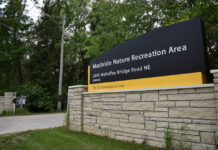Rebekah and Nick Neuendorf stand inside the soon-to-open Dance-Mor Ballroom in Swisher on a recent afternoon. PHOTO DAVE DEWITTE
By Dave DeWitte
[email protected]
“We’re waking up the sleeping giant,” said Nick Neuendorf, still excited about reopening Swisher’s Dance-Mor Ballroom after months of pounding and painting the place back into shape.
Dance-Mor was already well into its twilight years on May 24, 2014, when previous owner Craig Davis turned out the lights and locked the doors on the old building next to the railroad tracks on Main Street. Mr. Neuendorf and wife Rebekah, who is co-owner of the town’s Black Squirrel Pub, decided to take a chance on reopening it, and signed the papers this March.
The Neuendorfs got a fairly good deal on the property, which had been on the market for a few years, found the goodwill surrounding the dance hall to be one of its greatest assets.
“We have a lot of friends in the community who’ve been coming in and helping out,” said Mr. Neuendorf, 36. “Everybody wants to hear the music coming out of Dance-Mor again.”
Ballrooms were once a vital part of the social fabric in Iowa, a place where relationships and musical careers began and were cemented. Some 72 ballrooms were pounding out rhythms on Saturday nights at the peak of the ballroom age, according to the Iowa Rock n’ Roll Hall of Fame, but 54 of those are now gone, leaving only a handful of survivors like the Electric Park Ballroom in Waterloo, the Surf Ballroom in Clear Lake and the Val-Air Ballroom in Des Moines. The Oelwein Coliseum, which dates back to 1928, reopened as a ballroom last year.
Dance-Mor, inducted into the Hall of Fame in 2005, once brought in big-name acts like Lawrence Welk, Glen Miller, Guy Lombardo, Sonny James, Conway Twitty, Bobby Goldsboro and Bobby Vee. It wasn’t unusual for patrons to travel an hour or two to catch a show at Dance-Mor, and it was the main attraction in the town of less than 900 residents.
The hall abuts Shelton’s Market, the town’s only grocery, where owner Fred Shelton has watched its rise and fall over the decades
Mr. Shelton said 650 people attended the wedding reception at Dance-Mor after his marriage 63 years ago, and while his grocery business is declining, he thinks the new owners have a good shot at reviving the dance hall.
“This place here [the grocery] is fading out because what people want is changing,” said Mr. Shelton. “But people still like to dance. … It [Dance-Mor] didn’t go down because it didn’t have enough business. It just closed because the fella running it got tired of running it.”
A grand reopening weekend is scheduled for Oct. 19-20. A $10 admission fee – $8 if purchased in advance – will get you an evening with the Bootjack Band and New Trick (Friday) or Two-Buck Chuck and Lonesome Road (Saturday). Warm-up acts will play from about 6-8 p.m., and the headliners will hit the stage at about 9 p.m.
The Neuendorfs “laughed a little bit when friends said, ‘you’re going to be overwhelmed with people,’” Ms. Neuendorf recalled. She and her husband were thinking they might get a couple hundred for opening night. Just days after they posted the opening event on the Dance-Mor Facebook page, however, 1,000 or so users had clicked “interested.”
A dance through history
Like many of the old country dance halls, Dance-Mor is no architectural gem. It’s a big white barn of a wood-frame building that shows its evolution over the years. The layout of the Dance-Mor is familiar to those who’ve frequented others across the state: Stage up front, booths along the side walls, mirror ball suspended in the middle, and a bar in the back, opposite the stage. A heavy metal rail in front of the bar was built to organize the drink line, which reputedly stretched to the other end of the building on its busiest nights.
It all began as a maple dance floor covered by a tent in a small amusement park that original owner Frank Stangler operated more than 87 years ago. When the canvas tent was rented out for offsite use, it was damaged by fire. Mr. Stangler decided to build a permanent roof and call it the Paramount Pavilion. In 1953, he had the structure fully enclosed with exterior walls.
Dance-Mor was acquired in 1974 by Harold Davis, a retired school superintendent. After Mr. Davis’ death, his wife LaVenia and later their son Craig continued to operate the business, keeping it in the Davis family for close to 40 years.
Bands who’ve played the hall say they like the acoustics, Mr. Neuendorf said, possibly because almost every surface in the building is wood, except for the row of small four-pane windows along the east side.
The Neuendorfs approached the updating of Dance-Mor with a reverence for its past and are trying to remove the signs of wear and tear without covering up the building’s almost rustic lines. Effort was taken to match some of the original light-blue interior paint scheme, Mr. Neuendorf said, although some of the contrasting colors, such as a red that struck a harsh note, were painted over.

“We’ve had so many people tell us, ‘Our grandparents met here, our grandparents got married here, our parents met here,’” Mr. Neuendorf recalled. “It would be a disservice to Dance-Mor to change it.”
He said many still remember their favorite booth, or the one where they were standing when they met that special someone. The challenge for the Neuendorfs will be to attract a whole new generation of dancers.
“The young millennials don’t know how to come out and socialize,” Mr. Neuendorf said, explaining that the concept of asking a stranger, or even a distant acquaintance, to dance would be foreign to many of today’s teens.
Getting the older crowd to come in won’t be so difficult, since many of them complain of a shortage of music venues that are geared toward dancing. Finding entertainment hasn’t been hard.
“A lot of bands that played here previously have reached out to us,” said Mr. Neuendorf. As a result, he said the most difficult part of booking acts so far has been making sure to pair acts with compatible sounds and playlists.
Creating a policy for families to enjoy Dance-Mor was another challenge, according to Ms. Neuendorf. After careful consideration, the decision was made to allow all ages until 9 p.m., and 21-and-over only after 9 p.m. To compensate younger customers who must leave by nine, admission will be half price for customers from age 6-20, and free for children five and under.
While not everyone’s been thrilled by the policy, Ms. Neuendorf said Dance-Mor will be selling alcohol under a beer-and-wine license, and that it was important to create a system that wouldn’t make the hall a magnet for underage drinking.
In addition to regular weekend shows, plans call for open mic nights and battle of the bands-type events to attract a different crowd and help stimulate the local music scene. The Neuendorfs are also toying with the idea of a shuttle service that would let groups rent a small room at the rear of the hall for semi-private parties, and include a bus to pick up and drop off guests. It’s an idea that fits in well with their previous experience running a tour service visiting Corridor wineries and breweries.
The Neuendorfs will also be looking at ways to bring more people to Swisher by cross-marketing with other businesses. The town’s small Main Street has been less quiet in the last year or two with the opening of two boutiques and the Black Squirrel. The local eatery Kava House has also become a destination for diners throughout the Corridor.
“Swisher’s in an interesting transition period, moving from what it has been to what it could be, and what a lot of the new families are requesting,” said Ms. Neuendorf, a “pastor’s kid” whose parents settled down in Swisher after moving many times. “We’d like to see more businesses come to town, and more events that are a draw for people. It’s just a cool community, and we’d love to see it grow.”




